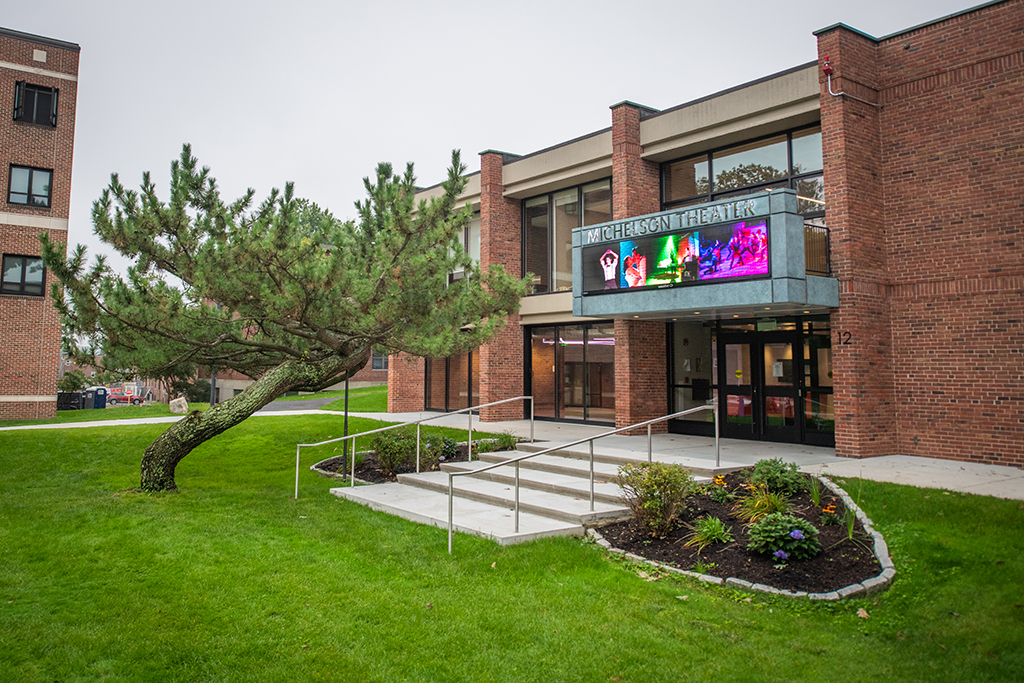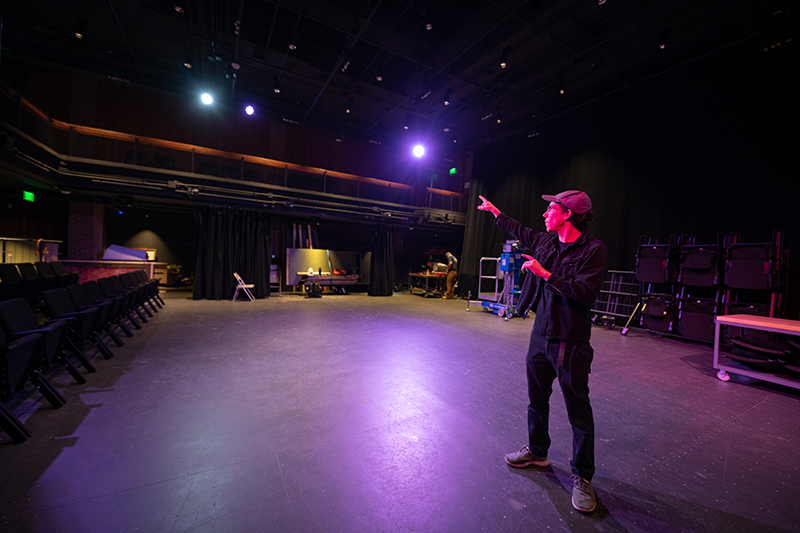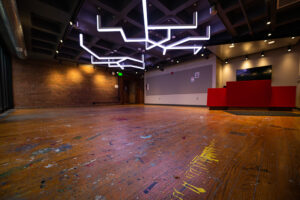Raising the curtain on Little Center’s next act

Anyone entering the newly remodeled Little Center lobby is walking on history — a colorful one. During the building’s recent renovations, the paint-splattered floor of the former sculpture studio was carefully preserved in the space that is now the lobby, creating an expanded welcome mat that seems to say, “Here, we make art.”
Built in 1964 as part of the award-winning Fuller Quad (along with two residence halls, Johnson and Sanford), the Little Commons was created as a space where the community could gather and included student lounges and a new dining area. In 1976, Little Commons became the Little Center and home to Clark University’s visual and performing arts programs.
In more recent years, while art and screen studies programs moved to the Traina Center for the Arts and music migrated to Estabrook Hall, the Little Center transformed into the busy hub for the University’s theatre arts programs. The building’s main performance space, a black box theater, was named in honor of Goldie Michelson, M.A. ’36, in 2009.

“The Little Center has always been the workhorse for the theatre program,” says Gino DiIorio, director of theatre arts at Clark. “On any given night, there would be performances downstairs and rehearsals in both spaces upstairs.” The building also included costume and scene shops, classrooms, and faculty offices.
Student clubs like Clark Musical Theatre, the Clark University Players Society, Shenanigans, Peapod Squad, Dance Society, Variant Dance, and even the Ballroom Dance team, could be found in the Little Center, honing their craft.
But like any 50-year-old space, time and use took their toll, and updating Little Center became imperative to continue supporting the active theatre community and delivering high-quality productions.
The building has “the same bones, new guts,” says Professor Kevin McGerigle, technical director. “The Little Center has been completely modernized. On the performance side, we’ve got new lighting, new sound, a new grid, reimagined floor plan. From a quality-of-life side, there have been major accessibility upgrades, the addition of an elevator, water fountains, and more bathrooms.”
Clark Trustee Vickie Riccardo, P ’17, and her husband Don Spencer, P ’17, donated $2 million toward the creation of the Riccardo and Spencer Lobby, a vibrant, art-filled lobby and reception area that also includes a dedicated ticket booth and much-improved bathrooms.
“The new and improved space will only add to the quality experience in the building,” DiIorio says.
The new elevator will allow all members of the community to access the second floor, and a new HVAC system will increase comfort for all. The elevator also will allow larger theatrical objects such as costumes and lighting supplies to move seamlessly between floors.
Professor Jessie Darrell Jarbadan is especially grateful for the new climate control. Before the renovations, costumes and props fell victim to environmental factors that led to “warping, cracking, growing mold, or otherwise accelerating of their natural decomposition in unexpected ways,” Jarbadan says.

While these improvements can be enjoyed by all Clark community members, spaces unseen by audiences will benefit students, professors, directors, and performers.
Jarabadan is excited about a large workspace dedicated to costume design that will include a washer-dryer, work sink, cutting table, mannequins, sewing machines, and dressing rooms.
“The ability to employ more costume construction and embellishment techniques will greatly increase the level of design and detail that we can accomplish for our productions,” she says.
On the production side, the renovations have opened a new world of possibilities for the University’s performance groups. The Michelson Theater is now equipped with LED screens, automation, computer numerical control production, and intelligent lighting, he says.
“We now have two modern, flexible performance spaces,” McGerigle says. “The main theatre is going to be great for large shows, improv shows, and dance shows. The experimental theatre is very intimate and flexible for small shows, readings, and rehearsals. And the three classrooms offer space for all types of performance groups to meet.”
The enhancements will naturally lead to expansion within the theatre program, DiIorio says. In the upcoming year, roughly 20 classes will be held at the Little Center, and “the plan is to expand that even further down the road.”
McGerigle, who was heavily involved in the renovation process, is already directing the first production that will be performed in the renovated Michelson Theatre, Stephen Sondheim’s “Assassins.” Opening night is Thursday, Nov. 10, with performances through Sunday, Nov. 13.
But McGerigle says he is most excited to “come home.”
“After COVID and construction, it is going to be amazing to have all our groups back working and collaborating under one roof. Being able to walk through the building and hear the sound of a tap dancer, a Shakespeare monologue, and a sewing machine all mixing together is truly magic.”


